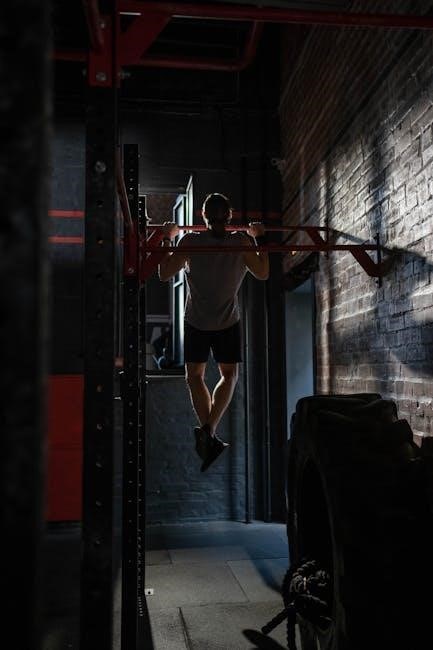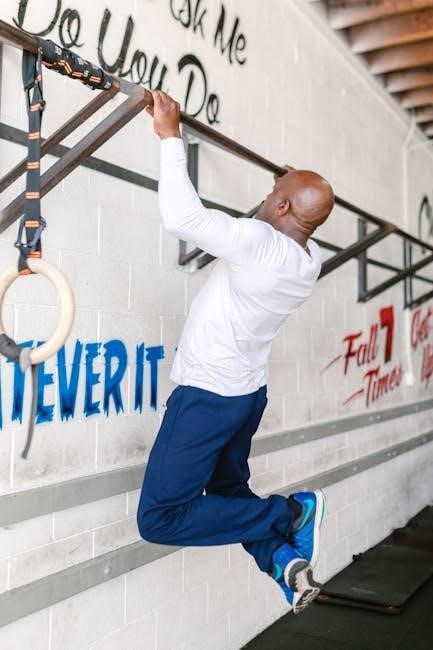A pull-up training program is a structured plan designed to improve upper body strength and endurance through progressive exercises. It helps individuals master pull-ups effectively.
1.1 What is a Pull-Up Training Program?
A pull-up training program is a structured plan designed to help individuals build the strength‚ endurance‚ and technique needed to perform pull-ups effectively. It typically includes a series of exercises‚ workouts‚ and progressive challenges tailored to improve upper body strength‚ particularly in the back‚ shoulders‚ and arms. These programs often vary in duration‚ intensity‚ and focus‚ catering to different fitness levels‚ from beginners to advanced athletes. The goal is to create a systematic approach to mastering pull-ups and achieving overall upper body fitness.
1.2 Benefits of a Structured Pull-Up Training Program
A structured pull-up training program offers numerous benefits‚ including improved upper body strength‚ enhanced muscle endurance‚ and better overall fitness. It helps individuals progress systematically‚ whether they’re beginners or advanced. These programs often include varied exercises to target multiple muscle groups‚ ensuring balanced development. They also promote time efficiency‚ as workouts are tailored to achieve specific goals. By following a structured plan‚ individuals can avoid plateaus‚ stay motivated‚ and see consistent progress. This approach not only builds physical strength but also boosts confidence and overall well-being.
Key Components of a Pull-Up Training Program PDF
A pull-up training program PDF typically includes workout structure‚ exercise selection‚ warm-up routines‚ and progressive overload strategies to ensure effective and safe training progression for all fitness levels.
2.1 Workout Structure and Scheduling
A well-structured pull-up training program PDF outlines a clear schedule‚ ensuring consistency and progression. Typically‚ workouts are divided into 3-4 sessions per week‚ focusing on pull-up-specific exercises‚ auxiliary workouts‚ and recovery days. The program often includes dynamic warm-ups‚ core strengthening exercises‚ and pull-up variations to build strength and endurance. Scheduling is designed to allow adequate recovery time‚ preventing overtraining while promoting muscle growth. Progressive overload is incorporated by increasing reps or intensity weekly‚ ensuring continuous improvement. This structured approach helps individuals stay motivated and track their progress effectively‚ leading to steady gains in pull-up performance over time.
2.2 Exercise Selection and Progression
Effective pull-up training programs focus on selecting exercises that target the necessary muscle groups‚ such as lats‚ shoulders‚ and core. The program begins with foundational exercises like assisted pull-ups‚ negative pull-ups‚ and isometric holds‚ progressing to full pull-ups as strength improves. Auxiliary exercises like lat pulldowns and rows are also included to build complementary strength. Progression involves increasing reps‚ reducing assistance‚ or introducing variations like wide-grip or weighted pull-ups. The goal is to match exercises to the individual’s fitness level‚ ensuring continuous challenge and improvement. This structured approach ensures muscle development and technique refinement.
2.3 Warm-Up and Cool-Down Routines
A proper warm-up prepares the muscles for pull-up training‚ reducing injury risk. Dynamic stretches like arm circles‚ shoulder rolls‚ and wrist extensions are essential. Incorporating light cardio‚ such as jumping jacks or rowing movements‚ increases blood flow. For cool-down‚ static stretches like child’s pose‚ cat-cow‚ and hamstring stretches help improve flexibility and reduce muscle tension. Foam rolling or self-myofascial release can also aid in muscle recovery. A well-structured warm-up and cool-down routine enhances performance and supports overall recovery‚ making them critical components of any pull-up training program.

Sample 9-Week Pull-Up Training Program
This structured plan spans nine weeks‚ focusing on building strength‚ increasing repetitions‚ and mastering advanced techniques for optimal results.
3.1 Week 1-3: Building Foundation Strength
Weeks 1-3 focus on establishing a strong foundation through exercises like push-ups‚ planks‚ and assisted pull-ups. These exercises target the muscles essential for pull-ups‚ such as the latissimus dorsi‚ biceps‚ and core. The goal is to build baseline strength and endurance. Participants start with manageable sets and gradually increase repetitions. Techniques like negative pull-ups and isometric holds are introduced to improve control and confidence. Consistency and proper form are emphasized to prevent injury and set the stage for progression in later weeks.
3.2 Week 4-6: Increasing Repetitions and Intensity
Weeks 4-6 focus on increasing the number of repetitions and intensity. Participants graduate to unassisted pull-ups‚ aiming to complete more reps in each set. Weighted pull-ups and plyometric variations are introduced to challenge strength and power. Auxiliary exercises like inverted rows and lat pulldowns are intensified to support progression. The emphasis is on maintaining proper form while pushing through higher volumes. This phase builds muscular endurance and prepares individuals for more advanced movements in the final weeks of the program.
3.3 Week 7-9: Advanced Techniques and Mastery
Weeks 7-9 focus on refining technique and introducing advanced variations to enhance strength and control. Participants explore weighted pull-ups‚ plyometric variations‚ and isometric holds to further challenge their abilities. Auxiliary exercises like single-arm pull-ups and inverted rows are refined for maximum effectiveness. The emphasis shifts to mastering form and efficiency‚ ensuring each rep is executed with precision. This phase culminates in assessing progress and preparing for sustained‚ long-term improvement‚ marking the transition from foundational strength to advanced mastery.

Assessing Your Current Fitness Level
Evaluating your fitness level is crucial for creating an effective pull-up training program. Start with a baseline pull-up assessment to measure strength and endurance capabilities.
4.1 Baseline Pull-Up Assessment
A baseline pull-up assessment measures your current strength and endurance. Start with a max effort attempt to determine the number of pull-ups you can perform in one set. Rest for 48-72 hours‚ then repeat the test to ensure accuracy. If you cannot perform a full pull-up‚ use an assisted version or negatives to gauge your starting point. This evaluation helps create a personalized program and track progress over time. Accurate results ensure the program is tailored to your fitness level for optimal improvement and safety.
4.2 Identifying Strength and Endurance Gaps
After completing the baseline assessment‚ analyze your results to pinpoint areas needing improvement. If you struggle with full pull-ups‚ focus on building upper body strength and endurance. Identify gaps in your ability to perform consecutive reps or hold positions. Use exercises like assisted pull-ups‚ negatives‚ or resistance band work to target weak points. Addressing these gaps ensures a well-rounded program that bridges your current fitness level to your goals. This step is crucial for creating a tailored plan that fosters steady progress and minimizes plateaus.

Choosing the Right Equipment for Pull-Up Training
Choosing the right essential equipment enhances your pull-up training effectiveness. Invest in a sturdy pull-up bar‚ resistance bands‚ and consider gloves for a proper grip and comfort. Prioritize quality to prevent injuries and ensure durability.
5.1 Pull-Up Bars and Accessories
A sturdy pull-up bar is the cornerstone of any effective training program. Choose between wall-mounted‚ ceiling-mounted‚ or portable options‚ ensuring durability and stability. Look for bars made from high-quality materials like steel‚ with a weight capacity that suits your needs. Accessories such as resistance bands can enhance your workouts by providing assistance or adding resistance. Additionally‚ wrist straps and grip enhancers can reduce strain and improve your grip during exercises. Investing in the right equipment ensures safety‚ comfort‚ and optimal performance throughout your pull-up training journey.

5.2 Resistance Bands and Assistive Tools
Resistance bands are versatile tools that can enhance your pull-up training by offering varying levels of resistance. They are ideal for both beginners and advanced trainees‚ providing assistance during pull-ups or adding resistance for strength building. Other assistive tools‚ such as chin-up machines or weighted belts‚ can help target specific muscle groups or provide support during exercises. These tools are designed to make workouts more effective and tailored to individual fitness goals. Incorporating them into your routine can maximize progress and ensure a well-rounded training experience.
The Role of Progressive Overload in Pull-Up Training
Progressive overload is a systematic approach to increasing exercise intensity‚ essential for continuous strength gains in pull-up training. It involves gradually adding reps‚ resistance‚ or volume to challenge muscles‚ promoting adaptation and improvement over time. This method ensures steady progress and helps achieve advanced pull-up variations‚ making it a cornerstone of effective training programs.
6.1 Understanding Progressive Overload
Progressive overload is a core principle in strength training‚ involving the gradual increase of exercise intensity to challenge muscles. It requires systematically adding reps‚ resistance‚ or volume to workouts. This approach ensures continuous improvement‚ preventing plateaus by forcing muscles to adapt. Consistency and tracking progress are key‚ as gradual increases in load or reps signal strength gains. Over time‚ this method builds the endurance and power needed for advanced pull-up variations‚ making it essential for achieving long-term goals in pull-up training programs.
6.2 Implementing Progressive Overload in Your Routine
Implementing progressive overload involves gradually increasing the challenge in your workouts to build strength. Start by assessing your current pull-up capability to set a baseline. Each week‚ aim to add one to two reps or incorporate resistance‚ such as weighted vests or bands. Track progress in a log to monitor improvements. Focus on perfect form and rest adequately between sets to avoid injury. Over time‚ this consistent approach will enhance your endurance and strength‚ making advanced pull-up variations achievable. Stay committed to see measurable gains in your pull-up performance.
Pull-Up Variations for Different Fitness Levels
Pull-up variations cater to all fitness levels‚ from assisted and band-assisted for beginners to weighted and single-arm pull-ups for advanced trainees. These variations help progress and challenge.
7.1 Beginner-Friendly Pull-Up Alternatives
Beginner-friendly pull-up alternatives include resistance band pull-downs‚ assisted pull-ups using machines or partners‚ and negative pull-ups. These exercises reduce the intensity while building foundational strength. Resistance bands provide variable resistance‚ making it easier to perform repetitions. Assisted pull-ups‚ either with a machine or a spotter‚ allow individuals to complete reps with partial assistance. Negative pull-ups focus on the lowering phase‚ helping build control and endurance. These alternatives are essential for progressing toward unassisted pull-ups and are tailored to individual fitness levels.
7.2 Advanced Pull-Up Variations for Increased Difficulty
Advanced pull-up variations include wide-grip‚ weighted‚ and single-arm pull-ups to increase difficulty. Wide-grip pull-ups target the lats more intensely‚ while weighted pull-ups add resistance using a belt or vest. Single-arm pull-ups require immense strength and control‚ isolating each side. Another variation is the towel pull-up‚ which enhances grip strength by hanging towels over the bar. For added challenge‚ athletes can incorporate L-sit pull-ups‚ holding the legs straight throughout the movement. These variations challenge even experienced individuals‚ pushing their strength‚ endurance‚ and technique to new levels while avoiding plateaus.

Nutrition and Recovery for Optimal Pull-Up Performance
Proper nutrition and recovery are essential for enhancing pull-up performance. A balanced diet rich in protein supports muscle growth‚ while adequate rest and sleep aid in repair and strength.

8.1 Importance of Protein and Nutrition
Nutrition plays a vital role in pull-up performance‚ with protein being essential for muscle repair and growth. A balanced diet rich in lean proteins‚ complex carbohydrates‚ and healthy fats fuels workouts and aids recovery. Adequate hydration and electrolyte balance are also crucial for optimal physical function. Post-workout nutrition‚ including protein intake‚ helps replenish energy stores and supports muscle recovery. A well-planned diet ensures sustained energy levels and enhances overall training efficiency‚ making it a cornerstone of any successful pull-up program.
8.2 Recovery Techniques for Muscle Growth and Repair
Proper recovery is essential for muscle growth and repair during pull-up training. Techniques include stretching‚ foam rolling‚ and massage to reduce muscle tension. Adequate rest and sleep are critical‚ as they allow muscles to rebuild. Incorporating dynamic stretching and self-myofascial release can enhance flexibility and blood flow. Additionally‚ stress management through meditation or deep breathing can aid recovery. Ensuring adequate hydration and electrolyte balance supports muscle function. These recovery methods help prevent injury and promote sustained progress in your pull-up training program.

Common Mistakes to Avoid in Pull-Up Training

Common mistakes include poor form‚ overtraining‚ and neglecting auxiliary exercises. These errors can hinder progress and increase injury risk. Focus on proper technique and balanced effort.
9.1 Avoiding Poor Form and Technique
Poor form and improper technique are common pitfalls in pull-up training. These issues often stem from rushing movements or using momentum‚ which can lead to muscle imbalances and injuries. To maintain proper form‚ ensure a full range of motion by starting from a dead hang and pulling until your chest touches the bar. Avoid swinging or jerking movements‚ as they can strain your shoulders and lower back. Focus on engaging your core and pulling with your lats rather than relying solely on arm strength. Additionally‚ avoid using an overhand grip too frequently‚ as it may lead to wrist strain. Incorporate variations like neutral or underhand grips to distribute the workload evenly. Neglecting to control the descent can also compromise form‚ so lower yourself slowly to maintain muscle tension. Finally‚ never sacrifice proper technique for additional repetitions‚ as this can hinder progress and increase injury risk. Consistent attention to form ensures safer‚ more effective workouts and steady progress in your pull-up journey.
9.2 Overtraining and Injury Prevention
Overtraining is a common issue in pull-up programs‚ leading to fatigue‚ decreased performance‚ and increased injury risk. To prevent this‚ ensure adequate rest days and avoid excessive volume or intensity. Listen to your body and adjust your routine if experiencing persistent soreness or discomfort. Incorporate dynamic warm-ups and cool-downs to prepare muscles and enhance recovery. Avoid repetitive strain by varying exercises and focusing on controlled movements. Prioritize quality over quantity‚ as consistent‚ moderate training yields better results than overzealous workouts. Schedule regular deload weeks to allow your body to recover fully. Additionally‚ monitor your progress to avoid pushing beyond safe limits‚ as this can lead to injuries like shoulder impingement or tendon strains. By balancing intensity with recovery‚ you can maintain steady progress while safeguarding your health.
Tracking Progress and Setting Realistic Goals
Regularly track your pull-up progress using a journal to monitor exercises and achievements. Set specific‚ achievable goals and celebrate milestones to stay motivated and adjust routines effectively.
10.1 Keeping a Training Journal
A training journal is essential for monitoring progress in your pull-up program. Record each workout‚ including exercises‚ sets‚ reps‚ and weight used. Note improvements in strength and endurance. Reflect on challenges faced and adjustments made. Celebrate milestones‚ like increased pull-up numbers‚ to stay motivated. Reviewing your journal helps identify patterns and areas for improvement‚ ensuring a tailored approach to your training. Consistency in tracking leads to better accountability and long-term success in achieving your pull-up goals.
- Log each session’s details for clear progress tracking.
- Reflect weekly on achievements and areas to improve.
- Use insights to refine your training strategy.
- Celebrate milestones to maintain motivation.

10.2 Setting and Achieving Milestones
Setting realistic milestones is crucial for staying motivated and tracking progress in your pull-up journey. Break your long-term goal into smaller‚ achievable targets‚ such as increasing pull-up numbers weekly. Celebrate each milestone to stay encouraged and reflect on improvements. Use specific metrics‚ like completing a certain number of reps or mastering variations‚ to measure success. Adjust milestones as needed to stay challenged yet realistic. This structured approach ensures steady progress and reinforces commitment to your training program.
- Define clear‚ measurable goals aligned with your fitness level.
- Track progress and adjust milestones as you advance.
- Celebrate achievements to maintain motivation and confidence.
- Use milestones to stay focused and committed to your training.
Mind-Muscle Connection and Mental Preparation
Building a strong mind-muscle connection enhances focus and control during pull-ups‚ ensuring proper form and engagement. Mental preparation boosts confidence‚ helping you stay motivated and overcome challenges.
11.1 Building Mental Toughness
Building mental toughness is crucial for overcoming challenges in pull-up training. It involves cultivating resilience‚ discipline‚ and focus to push through difficult workouts. By setting realistic milestones and celebrating progress‚ you reinforce mental strength. Techniques like visualization and positive self-talk can enhance determination. Consistent effort and perseverance are key to staying motivated‚ even when facing plateaus. Tracking achievements and reflecting on improvements help maintain a strong mindset. Mental toughness not only aids in completing workouts but also in mastering the pull-up itself‚ making it as important as physical strength.
11.2 Staying Motivated Throughout the Program
Staying motivated is essential for consistent progress in a pull-up training program. Celebrate small milestones‚ like increasing rep count or mastering a variation‚ to maintain enthusiasm. Establishing a consistent routine and tracking progress in a journal can reinforce commitment. Surrounding yourself with supportive individuals or joining a fitness community also boosts motivation. Reminding yourself of long-term goals and the benefits of pull-up training‚ such as improved strength and confidence‚ helps overcome challenges. Downloadable PDF guides and visual progress trackers can further enhance motivation by providing clear direction and accountability.
Celebrate your progress and achievements in the pull-up training program. Use the skills and strength gained to continue your fitness journey‚ exploring new challenges and goals.
12.1 Celebrating Achievements and Progress
Celebrating your achievements is a crucial part of your pull-up training journey. Acknowledge every milestone‚ no matter how small‚ as it signifies progress and dedication. Reflect on how far you’ve come since starting the program‚ and take pride in your improved strength and endurance. Sharing your success with others can also motivate you to keep pushing forward. Whether it’s mastering your first pull-up or increasing your max reps‚ celebrating these victories will keep you inspired and committed to your fitness goals.
12.2 Continuing Your Fitness Journey Beyond the Program
After completing the pull-up training program‚ it’s essential to maintain momentum by setting new fitness goals. Use the strength and confidence gained as a foundation for exploring other exercises or sports. Consistency is key‚ so incorporate pull-ups into your regular routine to sustain progress. Consider advancing to more challenging variations or focusing on related areas like core strength or endurance. The skills and discipline developed will serve as a strong base for future fitness endeavors‚ ensuring continuous growth and improvement.
